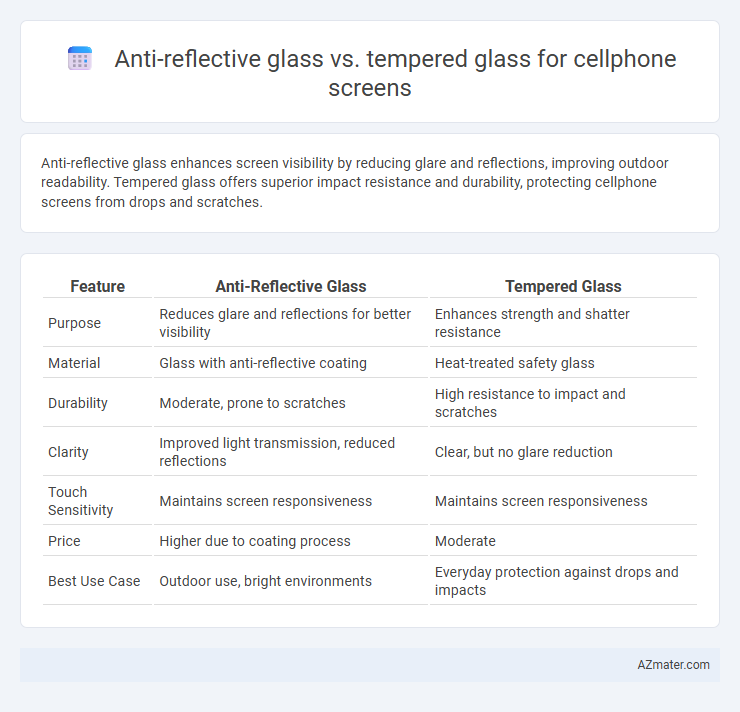Anti-reflective glass enhances screen visibility by reducing glare and reflections, improving outdoor readability. Tempered glass offers superior impact resistance and durability, protecting cellphone screens from drops and scratches.
Table of Comparison
| Feature | Anti-Reflective Glass | Tempered Glass |
|---|---|---|
| Purpose | Reduces glare and reflections for better visibility | Enhances strength and shatter resistance |
| Material | Glass with anti-reflective coating | Heat-treated safety glass |
| Durability | Moderate, prone to scratches | High resistance to impact and scratches |
| Clarity | Improved light transmission, reduced reflections | Clear, but no glare reduction |
| Touch Sensitivity | Maintains screen responsiveness | Maintains screen responsiveness |
| Price | Higher due to coating process | Moderate |
| Best Use Case | Outdoor use, bright environments | Everyday protection against drops and impacts |
Introduction to Cellphone Screen Protectors
Cellphone screen protectors enhance device durability by reducing scratches, impacts, and glare. Anti-reflective glass minimizes screen reflections and improves visibility in bright environments, while tempered glass offers superior strength and shatter resistance. Choosing between these materials depends on balancing display clarity with maximum protection for everyday use.
What is Anti-Reflective Glass?
Anti-reflective glass for cellphone screens features a special coating that reduces glare and reflections, enhancing visibility in bright environments and improving screen clarity. This coating minimizes light distortion and eye strain by allowing more light to pass through the glass, making it ideal for outdoor use. Unlike tempered glass, which focuses on impact resistance and shatter protection, anti-reflective glass prioritizes visual performance and user comfort.
What is Tempered Glass?
Tempered glass for cellphone screens is chemically treated to increase its strength and resistance to impact compared to standard glass. It undergoes a thermal or chemical tempering process that enhances durability, making it less likely to shatter upon drops or scratches. This type of glass is designed to provide maximum protection while maintaining clarity and touch sensitivity on smartphone displays.
Key Differences Between Anti-Reflective and Tempered Glass
Anti-reflective glass for cellphone screens minimizes glare and enhances visibility under bright light by reducing surface reflections through specialized coatings, whereas tempered glass provides robust impact resistance and shatter protection due to its heat-treated, strengthened structure. Anti-reflective glass focuses on improving user experience in various lighting conditions, while tempered glass prioritizes durability and drop protection. The key differences lie in their primary functions--glare reduction versus physical protection--and their effects on screen clarity and toughness.
Durability and Scratch Resistance Comparison
Tempered glass offers superior durability and impact resistance for cellphone screens, effectively preventing cracks and breaks from drops or heavy pressure. Anti-reflective glass enhances scratch resistance by reducing surface abrasions and maintaining screen clarity, though it may be more prone to damage from sharp objects compared to tempered glass. For optimal protection, tempered glass excels in durability, while anti-reflective coatings improve scratch resistance and visual performance.
Visual Clarity and Screen Visibility
Anti-reflective glass enhances visual clarity by minimizing glare and reflections, which improves screen visibility under bright lighting conditions such as sunlight. Tempered glass offers robust protection against scratches and impacts without significantly affecting display sharpness or color accuracy. Choosing anti-reflective glass boosts readability and color fidelity, while tempered glass prioritizes durability with moderate impact on screen clarity.
Touch Sensitivity and User Experience
Anti-reflective glass enhances touchscreen sensitivity by reducing glare and improving visibility under bright light, leading to a smoother and more accurate user experience. Tempered glass offers superior durability and impact resistance but may slightly reduce touch sensitivity due to its thicker and harder surface. Choosing anti-reflective glass prioritizes responsiveness and clarity, while tempered glass emphasizes protection, often impacting the overall tactile interaction.
Installation and Ease of Use
Anti-reflective glass for cellphone screens offers a smoother installation process due to its lightweight and flexible design, reducing air bubbles and misalignment risks. Tempered glass, while thicker and more rigid, requires precise handling during application to prevent cracking or improper adhesion, often demanding professional installation. Users typically find anti-reflective glass easier to apply independently, whereas tempered glass prioritizes durability but can complicate installation without experience.
Cost and Value for Money
Tempered glass offers robust protection against impacts and scratches at a moderate price, making it a cost-effective option for everyday use. Anti-reflective glass, while generally more expensive, enhances screen visibility by reducing glare and fingerprints, providing better user experience and value for those prioritizing display clarity. Evaluating cost versus longevity and visual quality helps determine the best investment based on individual cellphone usage and preferences.
Which Screen Protector is Best for Your Needs?
Anti-reflective glass reduces glare and enhances screen visibility under bright light, making it ideal for outdoor use and users who prioritize clear display quality. Tempered glass offers superior impact resistance and scratch protection, providing robust durability against drops and everyday wear. Choosing the best screen protector depends on whether you value enhanced screen clarity or maximum physical protection for your cellphone.

Infographic: Anti-reflective glass vs Tempered glass for Cellphone screen
 azmater.com
azmater.com